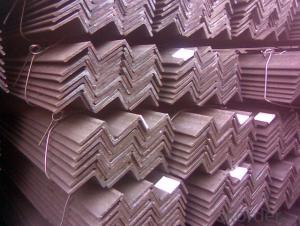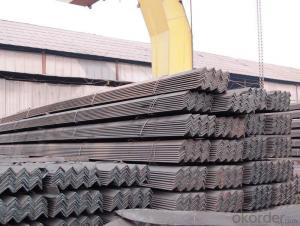Unequal Angle Steel Hot Rolled Steel, GB Standard Unequal Angle Steel
- Loading Port:
- Tianjin
- Payment Terms:
- TT or LC
- Min Order Qty:
- 25 m.t.
- Supply Capability:
- 20000 m.t./month
OKorder Service Pledge
OKorder Financial Service
You Might Also Like
Product Description:
OKorder is offering Unequal Angle Steel Hot Rolled Steel, GB Standard Unequal Angle Steel at great prices with worldwide shipping. Our supplier is a world-class manufacturer of steel, with our products utilized the world over. OKorder annually supplies products to European, North American and Asian markets. We provide quotations within 24 hours of receiving an inquiry and guarantee competitive prices.
Product Applications:
Unequal Angle Steel Hot Rolled Steel, GB Standard Unequal Angle Steel are ideal for structural applications and are widely used in the construction of buildings and bridges, and the manufacturing, petrochemical, and transportation industries.
Product Advantages:
OKorder's Unequal Angle Steel Hot Rolled Steel, GB Standard Unequal Angle Steel are durable, strong, and resist corrosion.
Main Product Features:
· Premium quality
· Prompt delivery & seaworthy packing (30 days after receiving deposit)
· Corrosion resistance
· Can be recycled and reused
· Mill test certification
· Professional Service
· Competitive pricing
Product Specifications:
Grade: Q235, Q235B, Q345, SS400, A36,St37-2
Standard: AISI, ASTM, GB, DIN, JIS
brand:nbsteels
MOQ:20mt
| Size( width*thickness )mm | width*thickness (kg/m) | Size( width*thickness )mm | width*thickness (kg/m) |
| 20*3 | 0.89 | 80*5 | 6.21 |
| 20*4 | 1.15 | 80*6 | 7.38 |
| 25*3 | 1.12 | 80*7 | 8.53 |
| 25*4 | 1.46 | 80*8 | 9.66 |
| 30*3 | 1.37 | 80*10 | 11.87 |
| 30*4 | 1.79 | 90*6 | 8.35 |
| 36*3 | 1.66 | 90*7 | 9.66 |
| 36*4 | 2.16 | 90*8 | 10.95 |
| 36*5 | 2.65 | 90*10 | 13.48 |
| 40*3 | 1.85 | 90*12 | 15.94 |
| 40*4 | 2.42 | 100*6 | 9.37 |
| 40*5 | 2.98 | 100*7 | 10.83 |
| 45*3 | 2.09 | 100*8 | 12.28 |
| 45*4 | 2.74 | 100*10 | 15.12 |
| 45*5 | 3.37 | 100*12 | 17.9 |
| 45*6 | 3.99 | 100*14 | 20.61 |
| 50*3 | 2.33 | 100*16 | 23.26 |
| 50*4 | 3.06 | 110*7 | 11.93 |
| 50*5 | 3.77 | 110*8 | 13.53 |
| 50*6 | 4.46 | 110*10 | 16.69 |
| 56*3 | 2.62 | 110*12 | 19.78 |
| 56*4 | 3.45 | 110*14 | 22.81 |
| 56*5 | 4.25 | 125*8 | 15.5 |
| 56*8 | 6.57 | 125*10 | 19.13 |
| 63*4 | 3.91 | 125*12 | 22.7 |
| 63*5 | 4.82 | 125*14 | 26.19 |
| 63*6 | 5.72 | 140*10 | 21.49 |
| 63*8 | 7.47 | 140*12 | 25.52 |
| 63*10 | 9.15 | 140*14 | 29.49 |
| 70*4 | 4.37 | 140*16 | 33.39 |
| 70*5 | 5.4 | 160*10 | 24.73 |
| 70*6 | 6.41 | 160*12 | 29.39 |
| 70*7 | 7.4 | 160*14 | 33.99 |
| 70*8 | 8.37 | 160*16 | 38.52 |
| 75*5 | 5.82 | 180*12 | 33.16 |
| 75*6 | 6.91 | 180*14 | 38.38 |
| 75*7 | 7.98 | 180*16 | 43.54 |
| 75*8 | 9.03 | 180*18 | 48.63 |
| 75*10 | 11.09 | 200*14 | 42.89 |
| 200*16 | 48.68 | ||
| 200*18 | 54.4 | ||
| 200*20 | 60.06 | ||
| 200*24 | 71.17 |
FAQ:
Q1: Why buy Materials & Equipment from OKorder.com?
A1: All products offered byOKorder.com are carefully selected from China's most reliable manufacturing enterprises. Through its ISO certifications, OKorder.com adheres to the highest standards and a commitment to supply chain safety and customer satisfaction.
Q2: How do we guarantee the quality of our products?
A2: We have established an advanced quality management system which conducts strict quality tests at every step, from raw materials to the final product. At the same time, we provide extensive follow-up service assurances as required.
Q3: How soon can we receive the product after purchase?
A3: Within three days of placing an order, we will begin production. The specific shipping date is dependent upon international and government factors, but is typically 7 to 10 workdays.
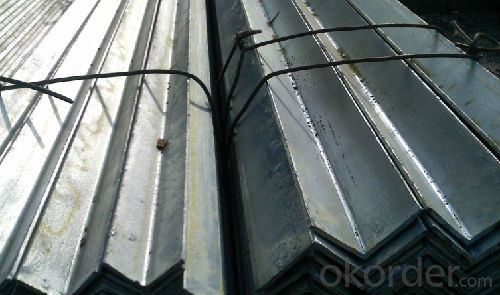
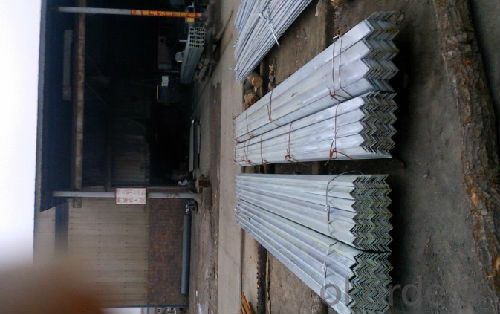
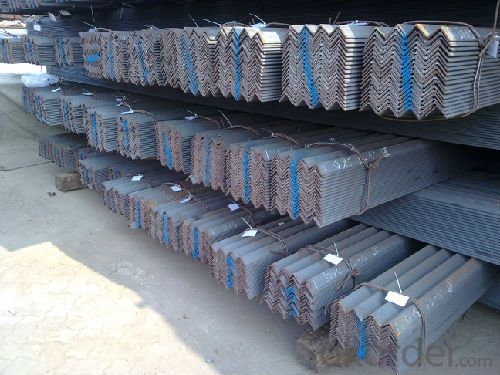
- Q:What is the weight of a steel angle?
- The weight of a steel angle can vary depending on its dimensions and composition.
- Q:What are the different specifications for steel angles?
- Steel angles, also referred to as angle irons or L-shaped bars, are utilized as versatile structural components in various industries. Their distinguishing feature is their L-shaped cross-section, which consists of two legs of either equal or unequal lengths. The dimensions of steel angles are determined by their leg lengths (L1 and L2) and thickness (T). The leg lengths can range from equal angles (L1 = L2) to unequal angles (L1 ≠ L2), with common leg lengths falling between 20mm and 200mm, and thicknesses typically ranging from 3mm to 20mm. In terms of material composition, steel angles are predominantly made from carbon steel, prized for its strength and durability. The choice of carbon steel grade employed is dependent on the specific application and the desired mechanical properties. Common grades include A36, A572, and A588. To ensure quality and consistency, steel angles are manufactured in adherence to various standards. These standards, such as ASTM (American Society for Testing and Materials), EN (European Norms), and JIS (Japanese Industrial Standards), establish guidelines for the chemical composition, mechanical properties, and tolerances of steel angles. Steel angles can possess different surface finishes to accommodate diverse applications and meet aesthetic requirements. Popular finishes include hot-dip galvanized, painted, or left as a mill finish (raw steel). Galvanized angles are coated with a layer of zinc for enhanced corrosion protection, while painted angles provide an additional layer of protection and can be customized in terms of color. To ensure conformity with required standards and suitability for structural applications, steel angles are subject to specific tolerances. These tolerances define acceptable deviations from the specified dimensions and can vary based on the manufacturing standard and the particular dimensions of the angle. In conclusion, the specifications for steel angles encompass dimensions (leg lengths and thickness), material composition (carbon steel grades), manufacturing standards (ASTM, EN, JIS), surface finish (galvanized, painted, mill finish), and tolerances. These specifications facilitate the selection of the appropriate steel angle for a given application, guaranteeing structural integrity and optimal performance.
- Q:Can steel angles be used for playground equipment?
- Yes, steel angles can be used for playground equipment. Steel angles provide strength, durability, and stability, making them suitable for various playground structures such as swing sets, climbing frames, and slides.
- Q:What are the advantages of using steel angles in manufacturing?
- There are several advantages of using steel angles in manufacturing. Firstly, steel angles are incredibly strong and durable, making them suitable for a wide range of applications. They can withstand heavy loads and provide structural stability, making them ideal for constructing buildings, bridges, and other infrastructure projects. Secondly, steel angles offer versatility in design. They can be easily customized and fabricated into various shapes and sizes, allowing manufacturers to create products that meet specific requirements. Whether it's a simple bracket or a complex framework, steel angles can be adapted to fit the desired design. Furthermore, steel angles have excellent corrosion resistance properties. They can withstand exposure to moisture, chemicals, and other environmental factors, which makes them suitable for outdoor applications and in industries where corrosion is a concern. Another advantage of using steel angles is their cost-effectiveness. Steel is a relatively inexpensive material compared to alternatives such as aluminum or stainless steel. Additionally, steel angles have a long lifespan, requiring minimal maintenance and replacement, which helps reduce overall costs in the long run. Lastly, steel angles are readily available in the market. They can be easily sourced from steel suppliers, making them accessible to manufacturers around the world. In conclusion, the advantages of using steel angles in manufacturing include their strength, versatility, corrosion resistance, cost-effectiveness, and availability. These factors make steel angles a preferred choice for various industries, enabling them to produce high-quality, durable, and cost-efficient products.
- Q:Can steel angles be used in the construction of power plants?
- Steel angles are indeed suitable for use in power plant construction. They are frequently employed to provide structural support and stability, as well as to withstand heavy loads. In power plant construction, steel angles have several applications, including framing structural components, supporting machinery, reinforcing concrete structures, and ensuring the overall structural integrity of the plant. Moreover, steel angles are highly resistant to corrosion, which is especially crucial in power plants where they are exposed to high temperatures, moisture, and chemicals. Thus, the versatility, strength, and durability of steel angles make them an excellent option for constructing power plants.
- Q:Can steel angles be used for handrails?
- Yes, steel angles can be used for handrails. Steel angles are often used as a structural component for handrails due to their strength and durability. They can provide a sturdy and stable support for handrails in various applications.
- Q:What are the disadvantages of using steel angles?
- Using steel angles in various applications comes with several drawbacks. One major disadvantage is their vulnerability to corrosion. These angles are typically made from carbon steel, which tends to rust when exposed to moisture and harsh environmental conditions. As a result, their structural integrity weakens over time, reducing their durability. Another drawback is their weight and bulkiness. Steel angles are often heavy and cumbersome, making them challenging to handle and transport. This can drive up project costs, as special equipment or additional labor may be necessary for installation. Steel angles also have limited flexibility and versatility in terms of design. They are usually only available in standard sizes and shapes, which restricts their use in certain applications that require customized or intricate designs. This lack of flexibility can lead to additional expenses for fabrication or the need for alternative materials. Moreover, steel angles tend to be more expensive compared to materials like aluminum or wood. This makes them less cost-effective in certain projects, especially when alternative materials can meet the structural requirements at a lower cost. Lastly, steel angles conduct heat and electricity, which may not be desirable in certain applications. This poses safety risks in environments that are sensitive to heat or electricity, necessitating additional insulation or protective measures. In conclusion, although steel angles offer advantages like high strength and durability, their disadvantages include susceptibility to corrosion, weight and bulkiness, limited design flexibility, higher cost, and heat and electricity conductivity. These factors should be carefully evaluated when deciding whether to use steel angles in a specific project.
- Q:How do steel angles perform in terms of sound insulation?
- Steel angles are not known for their sound insulation properties. Due to their rigid and dense nature, steel angles have little ability to absorb or dampen sound waves. This means that they do not provide significant sound insulation on their own. However, when used in combination with other materials such as acoustic insulation, steel angles can contribute to the overall sound insulation of a structure. Additionally, the thickness and design of the steel angles can also have an impact on their sound insulation performance. Overall, while steel angles may not offer exceptional sound insulation properties, they can still play a role in improving the overall soundproofing of a building when used in conjunction with other soundproofing materials.
- Q:Can steel angles be used for electrical conduits?
- No, steel angles cannot be used for electrical conduits as they are not designed or suitable for carrying electrical wiring. Electrical conduits are typically made of materials such as PVC, steel, or aluminum that are specifically designed to safely enclose and protect electrical wires.
- Q:Can steel angles be used for architectural detailing?
- Indeed, architectural detailing can make use of steel angles. These versatile structural elements find application in diverse architectural scenarios. They serve to provide stability and support to structures, fulfilling framing, bracing, and reinforcing purposes. Examples of steel angle implementation can be observed in architectural features like window frames, door frames, staircases, and handrails, among others. Their inherent strength and durability render them fitting for both interior and exterior architectural designs. Furthermore, steel angles can be effortlessly tailored and manufactured to meet precise design specifications, empowering architects to conceive distinctive and visually appealing architectural details.
1. Manufacturer Overview |
|
|---|---|
| Location | |
| Year Established | |
| Annual Output Value | |
| Main Markets | |
| Company Certifications | |
2. Manufacturer Certificates |
|
|---|---|
| a) Certification Name | |
| Range | |
| Reference | |
| Validity Period | |
3. Manufacturer Capability |
|
|---|---|
| a)Trade Capacity | |
| Nearest Port | |
| Export Percentage | |
| No.of Employees in Trade Department | |
| Language Spoken: | |
| b)Factory Information | |
| Factory Size: | |
| No. of Production Lines | |
| Contract Manufacturing | |
| Product Price Range | |
Send your message to us
Unequal Angle Steel Hot Rolled Steel, GB Standard Unequal Angle Steel
- Loading Port:
- Tianjin
- Payment Terms:
- TT or LC
- Min Order Qty:
- 25 m.t.
- Supply Capability:
- 20000 m.t./month
OKorder Service Pledge
OKorder Financial Service
Similar products
New products
Hot products
Related keywords
